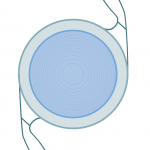Clareon® -Alcon Monofocal IOL
Cataract surgery is a transformative procedure that has evolved significantly over the decades. The surgery involves the removal of the eye’s natural lens when it has become clouded, a condition known as cataract. This clouding is often the result of natural aging but can also be caused by other factors such as diabetes, prolonged exposure to ultraviolet light, smoking, or the use of certain medications such as steroids.
Cataract surgery is one of the commonest surgeries performed worldwide. The procedure itself has a high success rate and is performed millions of times each year across the globe. It is typically done on an outpatient basis, meaning patients can go home the same day. The surgery usually takes less than an hour and is mostly pain-free due to the use of local anesthetics.
Understanding Intraocular Lenses (IOLs)
The concept of replacing the natural lens with an artificial one dates back to the 1940s, but it was not until the latter part of the 20th century that the use of IOLs became a standard practice in cataract surgery. These lenses are meticulously designed to mimic the function of the natural lens and are a permanent solution for cataract patients.
IOLs are made from a variety of materials, including silicone, acrylic, and other polymers that are well-tolerated by the body. They are also designed to be ultraviolet light-filtering to protect the retina. The power of the IOL is calculated before surgery by a test called biometry. The test measures the eye’s length and corneal curvature to provide IOL power that would give the best visual outcome for the patient.
The design of IOLs has also evolved, with options now including monofocal lenses, which are set for one level of vision (usually distance), and multifocal or accommodative lenses, which can help with both near and distance vision. The choice of IOL depends on various factors, including the patient’s lifestyle, visual needs, and the health of the eye.
Advantages of Clareon® IOL
The Clareon® IOL is made from a hydrophobic acrylic material, which is engineered to maintain clarity and resist lens opacification, a condition that can occur post-surgery where the IOL becomes cloudy due to cell growth. The Clareon® IOL’s material is designed to minimize this risk, thus potentially reducing the need for further intervention after cataract surgery. Dr Rehman Siddiqui’s work has shown that acrysof IOL material has less chances of posterior capsular opacification. https://pubmed.ncbi.nlm.nih.gov/35751355/
The Clareon lens is also characterized by its advanced aspheric design, which aims to improve contrast sensitivity and reduce spherical aberration, a type of visual distortion. This is particularly beneficial under low-light conditions, such as driving at night, where patients need to discern contrast and details. In summary:
- Optical Clarity: The proprietary material of the Clareon® IOL provides exceptional optical clarity, which is crucial for the restoration of high-quality vision.
- Biocompatibility: The hydrophobic acrylic material is highly biocompatible, reducing the risk of postoperative inflammation and providing a stable environment within the eye.
- Resistance to Opacification: The Clareon® IOL is resistant to both posterior capsule opacification (PCO) and anterior capsule opacification (ACO), common causes of vision deterioration after cataract surgery.
- Advanced Design: The aspheric design of the lens helps to enhance visual quality by reducing spherical aberrations, which can improve night vision and contrast sensitivity.
The Surgical Procedure
The implantation of the Clareon® IOL is performed during standard cataract Phaco surgery. The procedure begins with the creation of a small incision in the cornea, through which the surgeon inserts a tiny probe. This probe emits ultrasound waves to break up the cloudy lens into small pieces, which are then gently suctioned out of the eye, a process known as phacoemulsification.
Once the natural lens is removed, the Clareon® IOL is folded and inserted through the same small incision. It is then carefully unfolded and positioned into the lens capsule, which is the thin membrane that previously held the natural lens. The incision is usually self-sealing and does not require sutures, which minimizes recovery time and discomfort.
The precision of the Clareon® IOL’s design allows for a snug fit within the capsular bag, reducing the likelihood of lens dislocation or rotation post-surgery. The entire procedure is typically completed within 10 minutes , and patients often notice an improvement in vision within 24 hours.
Postoperative Care and Instructions
After the surgery, patients are provided with a set of postoperative care instructions to ensure a smooth recovery. These typically include:
- Medication: Patients are prescribed antibiotic eye drops [cataract-surgery-drops-schedule ] to prevent infection and anti-inflammatory eye drops to control swelling and discomfort
- Activity Restrictions: To prevent strain on the eye, patients are advised to avoid heavy lifting, strenuous exercise, and bending over for a 1 week after surgery.
- Eye Protection: Wearing protective eyewear, especially when sleeping, can help prevent accidental rubbing or bumping of the eye.
- Environmental Precautions: It is important to keep the eye clean and avoid exposure to dust, grime, and water, which can increase the risk of infection.
- Follow-up Visits: Regular appointments with the eye surgeon are crucial to monitor the healing process and to check the position and function of the Clareon® IOL.
Patients are also advised to report any signs of complications, such as increased pain, or loss of vision to their surgeon immediately.



